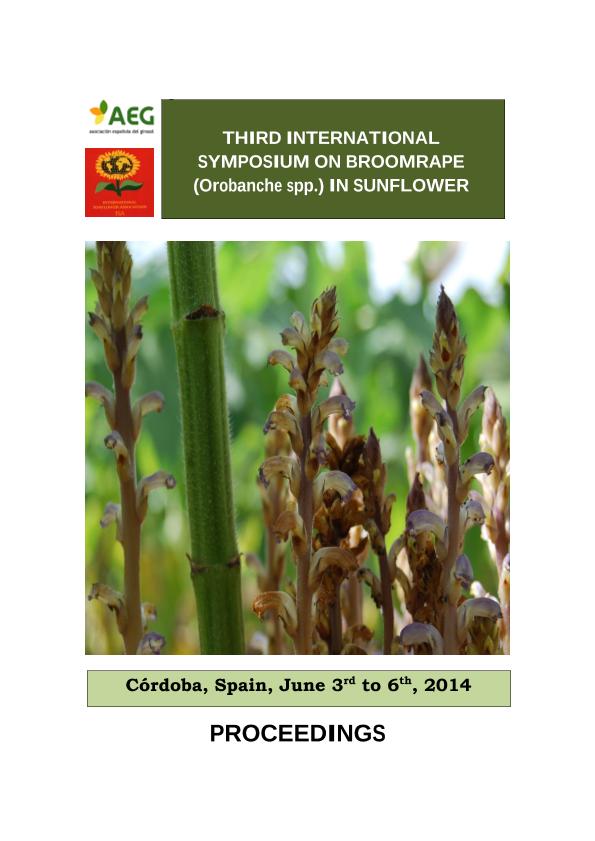Mostrar el registro sencillo del ítem
dc.contributor.author
Poverene, María Mónica

dc.contributor.author
Dimitrijević, Aleksandra
dc.contributor.author
Stojićević, Darko
dc.contributor.author
Božić, Dragana
dc.contributor.author
Vrbničanin, Sava
dc.contributor.author
Imerovski, Ivana
dc.contributor.author
Miladinović, Dragana
dc.contributor.author
Cantamutto, Miguel Ángel

dc.date.available
2024-04-05T17:49:33Z
dc.date.issued
2014
dc.identifier.citation
Broomrape occurrence in natural populations of annual Helianthus sp.; 3rd International Symposium on Broomrape (Orobanche spp) in sunflower; Córdoba; España; 2014; 169-172
dc.identifier.uri
http://hdl.handle.net/11336/232199
dc.description.abstract
Wild annual Helianthus species native to North America have demonstrated to be a valuable genetic resource for sunflower crop improvement. The search of genes for broomrape (Orobanche cumana Wallr.) resistance demonstrated a natural resistance to this parasitic weed in a wild sunflower species, H. petiolaris. This species along with the wild H. annuus form natural populations in extended areas of Argentina. In Europe, mostly the wild H. annuus is found across the main sunflower crop production areas. This species seems to be susceptible to the specialized parasitic weed, native from Europe. The environment and plant phenotypes of five wild H. annuus populations in their natural habitats in Argentina were compared to agrestal populations of H. annuus attacked by broomrape, located in Fernan Nuñez, Spain, and Kovilovo, Serbia. The study comprised four susceptible H. annuus and five resistant H. petiolaris populations. The goal was to realize if wild populations in Argentina could be in risk to be invaded by the parasitic weed. The plant morphology was not affected by the broomrape attack in Spain. Cluster analysis based on morphology showed differences among the two annual species but grouped H. annuus natural populations from Argentina and Europe. Clustering of ecological variables did not separate species and geographical localization. No differences in the environment for broomrape attacked and susceptible populations were found. Natural H. petiolaris populations could be considered a genetic resource for resistance against broomrape but natural H. annuus populations should be considered as a potential reservoir of the parasitic weed.
dc.format
application/pdf
dc.language.iso
eng
dc.publisher
Asociación Española de Girasol
dc.rights
info:eu-repo/semantics/openAccess
dc.rights.uri
https://creativecommons.org/licenses/by-nc-sa/2.5/ar/
dc.subject
Ecology
dc.subject
Morphology
dc.subject
Orobanche
dc.subject
Wild sunflower
dc.subject.classification
Agronomía, reproducción y protección de plantas

dc.subject.classification
Agricultura, Silvicultura y Pesca

dc.subject.classification
CIENCIAS AGRÍCOLAS

dc.title
Broomrape occurrence in natural populations of annual Helianthus sp.
dc.type
info:eu-repo/semantics/publishedVersion
dc.type
info:eu-repo/semantics/conferenceObject
dc.type
info:ar-repo/semantics/documento de conferencia
dc.date.updated
2024-01-19T10:14:27Z
dc.journal.pagination
169-172
dc.journal.pais
España

dc.journal.ciudad
Córdoba
dc.description.fil
Fil: Poverene, María Mónica. Universidad Nacional del Sur. Departamento de Agronomía; Argentina. Consejo Nacional de Investigaciones Científicas y Técnicas. Centro Científico Tecnológico Conicet - Bahía Blanca. Centro de Recursos Naturales Renovables de la Zona Semiárida. Universidad Nacional del Sur. Centro de Recursos Naturales Renovables de la Zona Semiárida; Argentina
dc.description.fil
Fil: Dimitrijević, Aleksandra. Institute of Field and Vegetable Crops; Serbia
dc.description.fil
Fil: Stojićević, Darko. University of Belgrade; Serbia
dc.description.fil
Fil: Božić, Dragana. University of Belgrade; Serbia
dc.description.fil
Fil: Vrbničanin, Sava. University of Belgrade; Serbia
dc.description.fil
Fil: Imerovski, Ivana. Institute of Field and Vegetable Crops; Serbia
dc.description.fil
Fil: Miladinović, Dragana. Institute of Field and Vegetable Crops; Serbia
dc.description.fil
Fil: Cantamutto, Miguel Ángel. Consejo Nacional de Investigaciones Científicas y Técnicas. Centro Científico Tecnológico Conicet - Bahía Blanca. Centro de Recursos Naturales Renovables de la Zona Semiárida. Universidad Nacional del Sur. Centro de Recursos Naturales Renovables de la Zona Semiárida; Argentina. Universidad Nacional del Sur. Departamento de Agronomía; Argentina
dc.relation.alternativeid
info:eu-repo/semantics/altIdentifier/url/https://www.isasunflower.org/fileadmin/documents/Symposia/3rdSymposiumBroomrape2014/SymposiumOrobancheCordoba.pdf
dc.conicet.rol
Autor

dc.conicet.rol
Autor

dc.conicet.rol
Autor

dc.conicet.rol
Autor

dc.coverage
Internacional
dc.type.subtype
Simposio
dc.description.nombreEvento
3rd International Symposium on Broomrape (Orobanche spp) in sunflower
dc.date.evento
2014-06-03
dc.description.ciudadEvento
Córdoba
dc.description.paisEvento
España

dc.type.publicacion
Journal
dc.description.institucionOrganizadora
Asociación Española de Girasol
dc.source.revista
Proceedings of the Third International Symposium on Broomrape (Orobanche spp.) in Sunflower
dc.date.eventoHasta
2014-06-06
dc.type
Simposio
Archivos asociados
